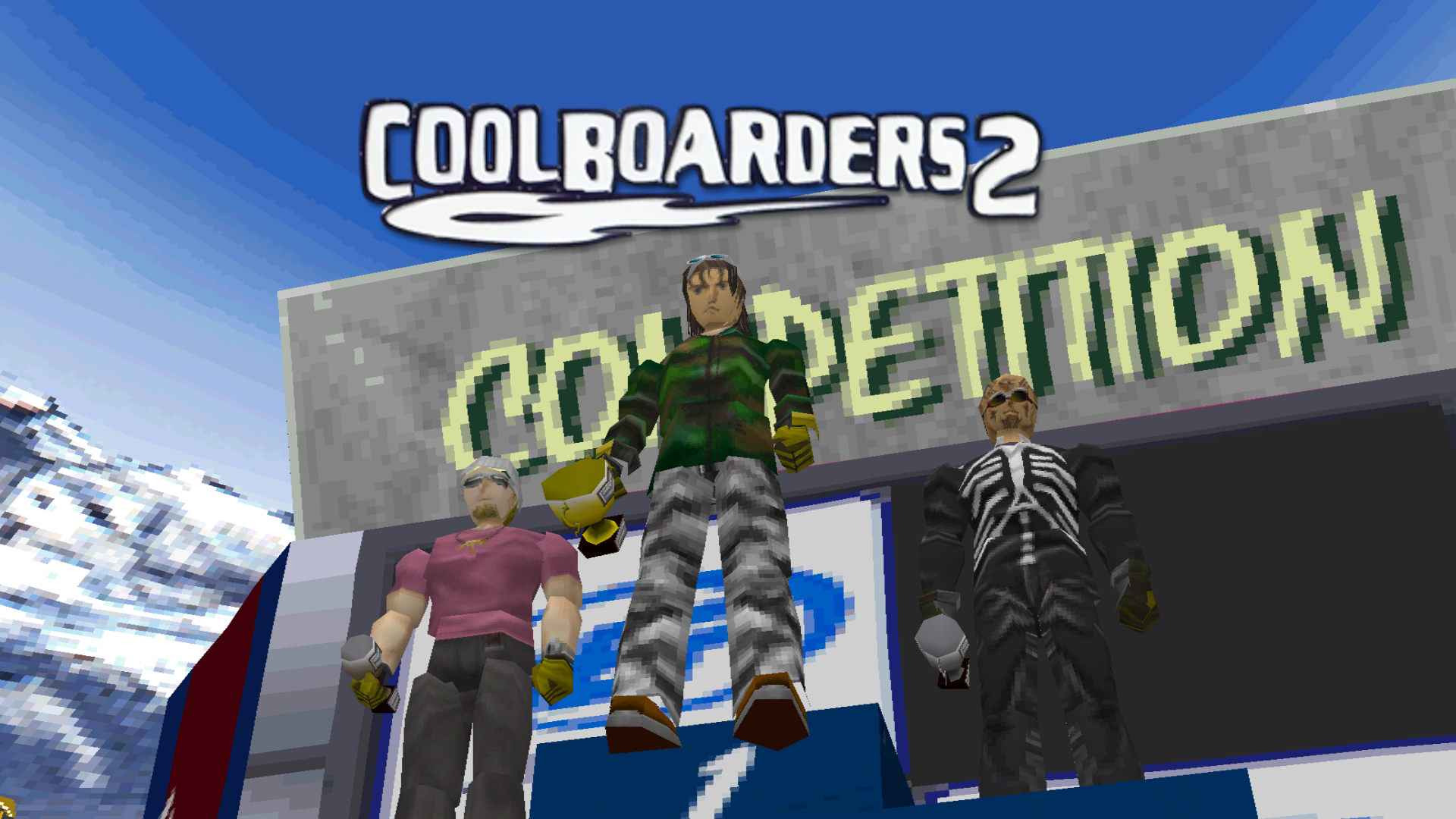Cool Boarders 2
Before there was Tony Hawk’s Pro Skater, SSX, and other notable “extreme sports” titles, one of the first major series was Cool Boarders. Released in 1996, the series would debut on the Sony PlayStation by UEP Systems, a short-lived yet impactful development studio. While they were best known for the Cool Boarders series, they also had another gem in their hands known as Rising Zan. Of the many titles in the series, Cool Boarders 2 holds a special place in my heart as it was one of the first video games I’ve ever played.
After the success of Cool Boarders, Sony realized that Japan’s popularity of snowboarding would transition well in the Western market. A year later in 1997, Cool Boarders 2 would release on the Sony Playstation worldwide, improving from its predecessor in every way. The game had twice the riders and levels over the original as well as the ability to race against 7 other racers. More on that later.
For now, the starting roster includes Yaggi, Jin, Cindy, and Irin. Yaggi is the “cover star” of Cool Boarders 2 and as expected from such, his stats are average. Jin has the highest top speed and toughness but is difficult to control through sweeping corners. Cindy is evenly balanced in acceleration and top speed, but not as tough with above-average stats. Lastly, Irin has the quickest acceleration and handling, but an abysmally low top speed and toughness so low a gust of wind could knock her over.

I would get introduced to the game, under Sony’s Greatest Hits banner, during the first year I owned a PlayStation. The PlayStation was the first console I’ve ever owned, which makes Cool Boarders 2 one of the first video games I’ve played. Even throughout my PS2 era of gaming, I’d return to this game despite there being more advanced snowboarding titles such as SSX 3. That’s because this game offers instant gratification to the player while also enticing them to explore all of its secrets.
Another reason is that outside of the main mode, Competition, there are many bonus levels and modes to get the most out of the experience. There’s Board Park, a training facility meant to teach the basics of Cool Boarders 2’s gameplay, a Big Air mode for best trick, a Contest mode that puts the player’s trick knowledge to the test, and lastly Freestyle mode. Of these modes, Freestyle mode will be the second most important mode as it’s the only way for players to play individual courses outside of Competition mode.
Competition mode pits the player against seven other riders over nine different courses. Each course is split into rounds, with the first stage of each round being a trick event. This event serves as a qualifier for the player’s placement in the race itself, so scoring high is almost a requirement to ensure victory in the race. Each rider enters the race in order, like a rally event, down to the final rider. This means that starting last will almost mean that the player will never catch up to the front of the pack. Likewise, starting first gives you the best chance at victory.

Gaining first place isn’t always the goal, however, as making the minimum competition entry points is what determines if you qualify for the next round. The first stage merely requires one point, for example, meaning that any placement that’s 7th or above will move you through to the next round. To make it to the last round, the player will need around 40 points. Since the player earns 9 points for placing first, the player will need to place first in four rounds and place above 8th for any of the following races to make it through to the end.
This makes Cool Boarders 2 one of the most lenient games to clear as you don’t need to win every race to progress. The player doesn’t even need to try after a certain point. To counter this, Cool Boarders 2 has some of the most complex courses I’ve seen in a snowboarding title. They are grounded by simple gimmicks as players carve across ridges, glide through the ice, carve through blind corners, and a combination of all the above. Despite this, the levels all range from a simple ski resort to ancient ruins, and a construction site.
When I first played this as a kid, I wasn’t utilizing all of the mechanics that Cool Boarders 2 provided. There were discoveries I’ve found today that the younger me always wondered were possible. One such situation was Pipeline Canyon, one of the later courses in the game. Racing through an industrial complex, there are pipes everywhere. Some pipes would appear as grindable, but I never understood the Grind mechanic in Cool Boarders 2 at first. It wasn’t like the Tony Hawk or Session games where you jump and press a button to grind on a rail. Doing so in this game required timing and balancing between pressing the L1 and R1 buttons.

It was really weird to pull off the first few times. For every tap, you would turn in a direction, while going straight would cause the boarder to eventually fall. Regardless, this opened up a shortcut I never knew existed for several courses. Shortcuts are usually cleverly hidden behind trees and waterfalls, although the AI would use said shortcuts themselves. Hidden behind a conveniently placed forest of trees in Take It Easy lies a giant chasm that a player will fall into if they became unaware. If the player makes the jump, it shaves off an entire technical section which is valuable for a course as short as that.
One of my favorite courses as a kid that even kept me on my toes now is Freezing Point. It’s one of the few night courses in the entire game. Coupled with a flurry of snow and it makes for one of the most terrifying courses in the game. Shifting through winding courses as you’re at the mercy of ice sheets, blind jumps, and a narrow bridge makes this a wild ride. For its grand finale, a stressful series of s-curves along a ridge can be avoided with a skillful hop over the ridge. This can be done twice, which feels amazing when pulling it off the first time.

It goes to show that despite releasing over 25 years ago, UEP Systems managed to create some unique courses with its personality. The gameplay and various levels make Cool Boarders 2 a classic as well as its replayability. Beating the Competition mode once unlocks Mirror Mode and clearing that unlocks the Hard difficulty. Doing this unlocks Boss, the “boss” character of Cool Boarders 2, with the best all-around stats. This also unlocks a new course, Dive Into The Cave, in which the player traverses through an inner network of caves, chasms, tight corners, and thin bridges, all in less than a minute.
Eventually, the player will unlock Gray the Alien and a Snow Man on a frying pan, both being the best characters for tricks and speed respectively. One thing that disappointed me about Cool Boarders 2 is the limited roster of characters. Remember how I said there are 7 other riders? Including the base roster and Boss, that’s five. The other three riders, Kelly, Jicchi, and Nick, are CPU only riders. For the longest time, it was an urban myth that doing something bogus would unlock the trio as selectable characters. Unfortunately, it’s been proven false, however, the fact that a Gameshark code doesn’t exist to at least play the characters is very interesting.



Cool Boarders 2’s success would put the series in an interesting predicament. As the success of Tony Hawk’s Pro Skater ushered in the golden era of Extreme Sports, the Cool Boarders franchise lived on to capitalize on this. However, starting with Cool Boarders 3, Sony would own the Cool Boarders branding in the west and they started to develop titles for the series in-house.
The developer, Idol Minds, would focus on the rest of the titles, ending with Cool Boarders 2001. Idol Minds are best known today as Deck Nine, the developers of Life Is Strange Before The Storm and True Colors. Before that, they worked in-house with Sony and worked primarily on racing titles. They did a good job, but it wasn’t the same energy that UEP Systems was known for bringing to their Arcade-like titles. UEP Systems would continue the series, but they would never release a Cool Boarders-titled game in the West after Cool Boarders 2.

The next ‘official’ Cool Boarders game would be known as Rippin’ Riders in the west as a Dreamcast exclusive. Titled Cool Boarders Burrrn in Japan, it was ironic that what was once Sony’s flagship snowboarding game, Cool Boarders, was now Sega’s. UEP Systems would release one more Cool Boarders game, titled Cool Boarders Code Alien. This was never released outside of Japan, for the reasons listed above. However, fans of the series have stated that this was the true sequel to Cool Boarders 2.
While Neversoft would usher in a new age of sports titles and Electronic Arts raising the popularity of Snowboarding games to its summit, UEP Systems was one of the first developers to create a 3D Snowboarding title. It may not be the most realistic when it comes to its culture, but it never had to be. Players who just want to experience a fast sense of speed (Seriously, going 80 mph downhill) with a cheesy announcer and a killer soundtrack should check Cool Boarders 2 out.


